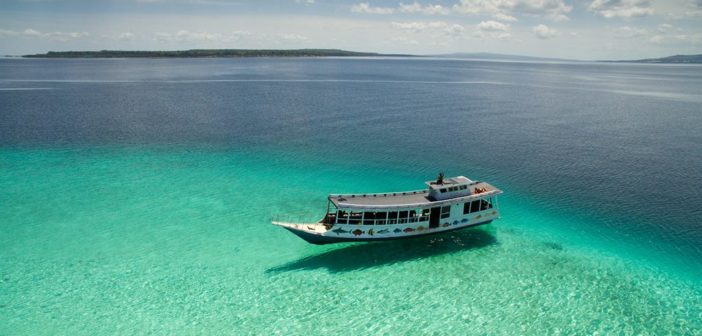After diving and travelling in Asia for nine months, I was given the opportunity to join Operation Wallacea for 8 weeks as a Divemaster. The location was Bau-Bau, the main city on the west side of Buton, situated in Sulawesi. Having travelled from Kuala Lumpur to Makassar via Bali, I was to catch a tiny aircraft to Bau-Bau airport. After being informed there are no direct flights here, I was prepared for some plane hopping.

The sun was setting as I was being driven to the Opwall HQ next to Nirwana Beach. I was greeted by a number of the friendly and welcoming staff here, including Mo who is the Site Manager and Imin, her husband, who is the Diving Coordinator. For those that don’t know, Operation Wallacea (Opwall) is a conservation project that has been running for over 20 years. Originating here in Indonesia, it now has 15 locations worldwide including Mexico, Honduras and the Galapagos Islands. You can check them out here. Students, marine biologists, scientists and divers are just some of the people that gather at the numerous locations to survey, study and discover ways of protecting areas and species that are at risk of being destroyed, mainly by human interference.
The next morning after eating the breakfast that had been prepared by the local staff, we put together our equipment and set out on one of the four boats used here during the season, Gerhana.
This is Imin’s personal boat, which is also used out of Opwall season by his own diving centre Wasage Divers. The boat can sustain up to 15 divers, has a sunroof, toilet facilities and a small kitchen area. We sailed 45 minutes west from Nirvana Beach to Pulau Ulurr, also known as Snake Island.

The small, uninhabited island sitting between Siumpu and Kadatua has large a large, sloping reef on the East side. Here we were treated to black-tip and white-tip reef sharks, blue spotted stingrays, nudibranch and an orang-utan crab.
During the season, students and teachers are given the opportunity to take their Open Water. Courses begin with confined water dives from the shore at Nirvana Beach. The sandy bottom is perfect for students to learn the necessary skills and to get comfortable with breathing underwater. They can also be introduced to blue spotted stingrays and flounders drifting across the sand-bed. There are many concrete blocks which provide artificial reefs for coral to grow and that attract different kinds of reef fish including moorish idols, hawkfish, damsels and the shy juvenile emperor angelfish. Venture further and you will find a three metre tall, igloo-shaped frame. This also attracts many different kinds of species from nudibranchs to giant frogfish, with moray’s and a variety of shrimps, crabs and pipefish surrounding the complex. If you have the time and enough air in your tank, you can search deeper at 16 metres and find another frame of the same size.
Head South of Nirwana beach and you will find Moko dive site. Abundant forests of branching coral in five-metre depth, this leads into a slope down to a sandy bottom at 15 metres. Along the slope you will find crevices with various marine life among the hard and soft corals including clownfish, sweetlips of all kinds (the juvenile harlequin can often be found doing his notorious dance), juvenile batfish and a plethora of nudibranchs. Cruise along the sand and you can find bottom feeders such as blue spotted stingray and flounders.
From the Opwall base stands a concrete jetty that stretches out into the Banda Sea. Whilst this makes for a spectacular photo of the sunset, it’s what lies beneath the surface at Pampanga 1+2 that provides the real show. A giant’s stride from the jetty will take you onto the plateau. At high tide, this is five metres depth where you will be welcomed by an array of hard and soft corals with many pipefish, gobies and crustaceans living amongst it. Head down the wall (which reaches 35m) to find more of this, along with fans, whips and many ledges in which crocodile flatheads and other creatures can be seen are lurking. Eagle rays can also be spotted if you venture along the wall.
Once the Operation Wallacea season had finished, a few of us were treated by DJ and Divemaster Dicky to a cave dive just a short boat ride from the harbour. The cave’s entrance lies slightly deeper than 25m, once you enter it is important to stay off the bottom as one kick will disturb the sand and could ruin your visibility. Although the pass is relatively wide (certainly enough for one person), you want to be sure to conserve your air and to keep off the bottom. On entering the mouth of the cave, you’re welcomed by an over-sized porcupine fish and several large lobsters scouting the perimeter of the cave. You make your way gradually through a chimney, checking out the boulders on the way up which house even more lobsters and crabs.
On your ascent there is an excellent photo opportunity, thanks to the ray of light streaming down into the open ceiling of the cave, giving it a “stairway to heaven” look about it. Even without a camera, it is a glorious sight. Once you complete a safety stop, you’re able to surface inside the cave; you may see the resident gecko’s hiding between the stalactites.

This should give you a taste of what you can expect from diving in Bau-Bau, and from my experience I would certainly recommend it. If you are looking to take up diving, the guys at Wasage Divers are experienced instructors and have been diving the area for many years, so you know you are in safe hands. For the divers already certified, there is a great opportunity to dive in some exciting and different environments; the variety of life under the ocean here means you are in for many surprises.







